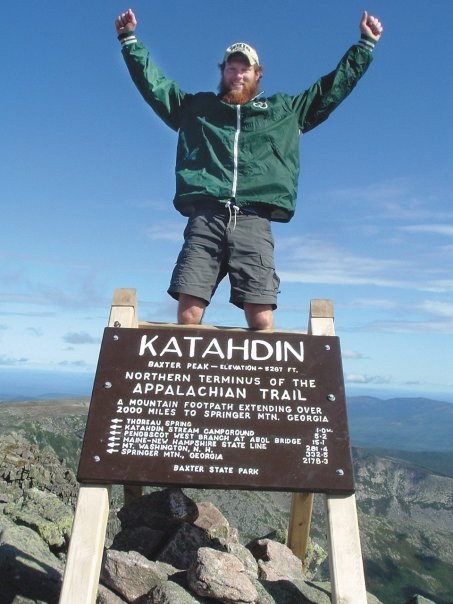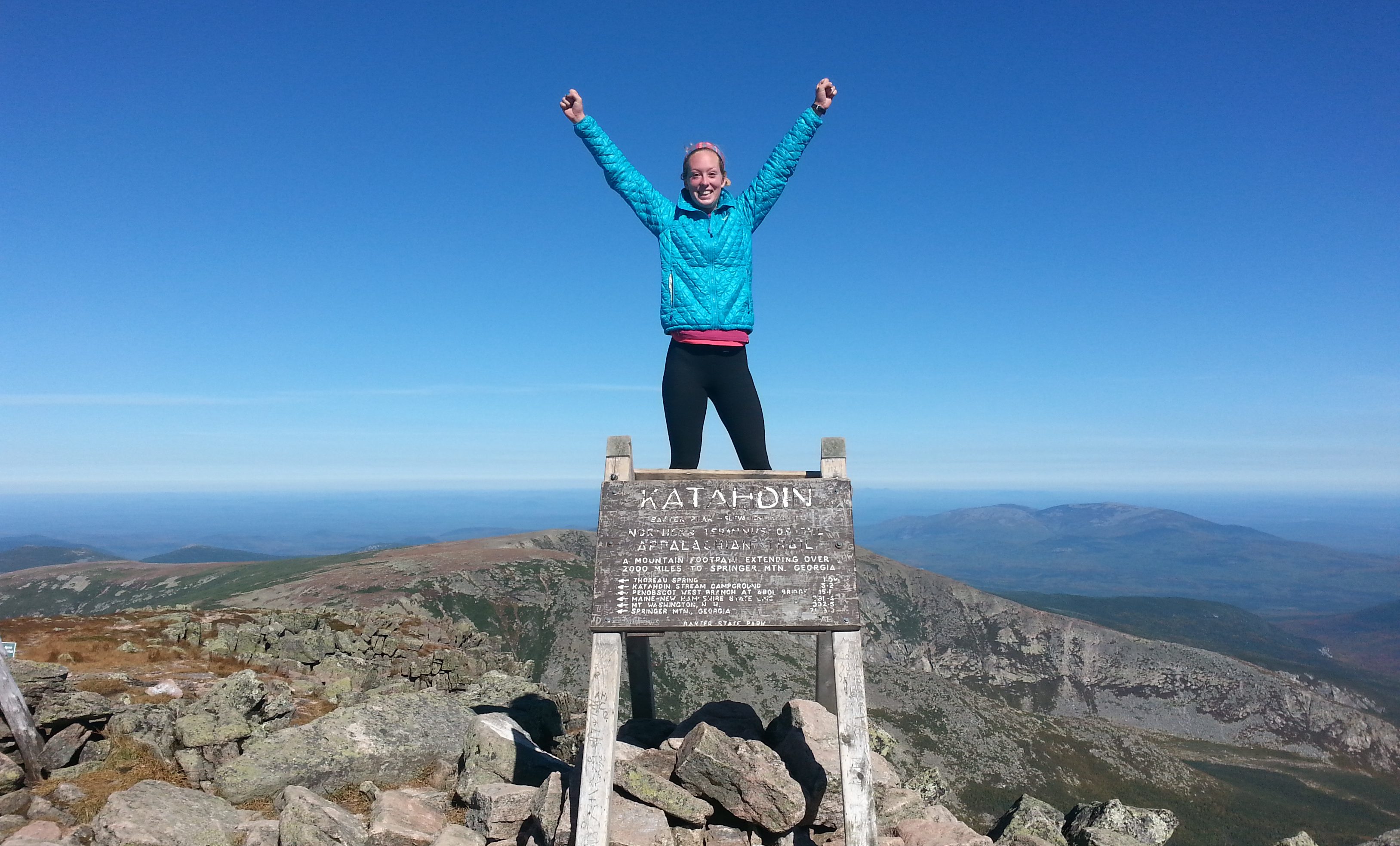But I got a great deal else from the experience. I learned to pitch a tent and sleep beneath the stars. For a brief, proud period I was slender and fit. I gained a profound respect for the wilderness and nature and the benign dark power of woods. I understand now, in a way I never did before, the colossal scale of the world. I found patience and fortitude that I didn’t know I had. I discovered an America that millions of people scarcely know exists. I made a friend. I came home.
—Bill Bryson, A Walk in the Woods: Rediscovering America on the Appalachian Trail (1997)
To hike the Appalachian Trail, that mythic ridge-top path that rises and stretches from Georgia to Maine, requires you to be rugged, qualify as an expert in outdoor training, posses a low pain tolerance, and eat literally like a bird. Right?
Not so, say Bobcats Adam Jones, BSETM ’12, and Kate Schmidlin, BSPE ’14, who thru-hiked the “AT”, as it’s known, at almost the same time, from March 2014 to September 2014. To reach personal milestones like they did with the final step at the summit after 2,185.3 miles, you only need resolve, a “more is less” philosophy regarding creature comforts, and stalwart friends who take the trail alongside you, the alumni say.
And, let’s face it: Being fit and in your early twenties doesn’t hurt, either.
Jones, who lives in Millersburg, Ohio, and Schmidlin, who will settle in Ashtabula, Ohio, after returning from a western U.S. road trip, met on the AT. Living on opposite ends of the Athens Campus as undergraduates prevented them from bumping into one another until crossing paths in Delaware.
“I didn’t meet her on the trail till Delaware Water Gap, which is almost 1,300 miles in,” Jones wrote in an e-mail. “I had heard through several hikers that this hiker ‘Tigger’ was also from Ohio and also attended Ohio University. I was stoked to catch up with a fellow Bobcat and see if our paths ever crossed.”
Schmidlin remembers encountering Jones after a long day trudging rain-soaked trails.
“I had wandered into camp with some buddies that I had been hiking with and Adam was sitting at camp wearing a green Bobcat tank top,” Schmidlin recalls in an e-mail. “I asked, ‘Are you a Bobcat? From Ohio?’ He lit up and we talked for a while. … We had never met before and were both pleasantly surprised to encounter each other so far from home.”
Each answered the same questions about the trek via e-mail. Read below edited excerpts. Also go to Schmidlin’s blog at https://klschmidl.wordpress.com/ —Kelee Garrison Riesbeck, BSJ ’91
Ohio Today: Why did you decide to hike the AT?
Kate Schmidlin: I decided I would hike the Appalachian Trail my sophomore year of high school. I was in the Expedition Academy, a program which took students on backpacking trips. We did a few days and nights on the AT. It was there that I met people who were thru-hiking and I was intrigued and inspired. I made a separate savings account that year and started saving up for my trip.
Adam Jones: I wasn’t completely content with where I was and it was something I wanted to do for a while. So I figured, why not now?

Adam Jones, BSETM ’12, commemorates the 2,185.3-mile trek by posing at the journey’s end in Mount Katahdin, Maine.
OT: Were you ever scared?
KS: Yes, occasionally. Luckily, the trail community was extremely supportive and protective. If I ever came across anyone or anything that was scary, I felt protected by the group of hikers I was near. The only time I was scared of animals was when I met a copperhead in Pennsylvania. I just about stepped on him and he struck at me, but missed. It was a close call.
AJ: The only really “scary” situation was hiking down the backside of [Mount] Katahdin in Maine, in a section called The Knifes Edge. You’re literally walking along a two-foot wide rocky ridge with no footpath and free climbing in some spots.
OT: Some say people enter a sort of “Zen state” when they take this kind of journey alone. Did you?
KS: I did enter a Zen state fairly often while I was hiking. It was sometimes too much alone time, but it forced me to be intentional with my thoughts and allowed me to practice meditating. I was lucky to meet a gang of people who I ended up spending a lot of time with and they helped ease the long and lonely days.
AJ: You definitely enter a sort of Zen state while you hike and it’s definitely a peaceful feeling. … I do like my alone time while hiking but you make so many friends on the AT that they become family, and you can’t wait to meet back up with them every evening. Those evenings spent with friends on the AT are what make the trip worthwhile.
OT: Is there something you wished you had packed? Something you chucked after you realized you didn’t need it? Do you pack differently for trips now?
KS: I packed too much initially, but quickly realized that I didn’t need everything I had. …(I) quickly sent home things that I was not using regularly or didn’t NEED (deodorant, razor, big knife, compass, books). I pack much lighter now. When you have to haul things for 2,185 miles, the line between “want” and “need” becomes much more distinct!
AJ: I definitely pack lighter for trips now. … When I began, my pack weighed in at 45 pounds, which is pretty hefty. Toward the end [it was] down to around 30-35 pounds. The farther along you get on the trail, the more you learn about the things you can do without. Someone on the trail told me, ‘You pack for what you fear,’ and I found it to be 100 percent true. If you’re afraid of getting cold, you over-pack cold weather gear.
OT: If you had to choose a theme that emerged from your trip, what would it be?
KS: Hike your own hike! The AT experience is completely different for everyone. After a while, I learned to go my own pace, take days off when I need them, and enjoy MY trip.
AJ: I realized how much we take for granted in our everyday lives. Hot water, mattresses, fresh food, flushing toilets, among many other things. … I came away wanting to simplify my life and get rid of things. If there was something in your pack you hadn’t used in one week, you sent it home or pitched it. You didn’t need it.
OT: Can you offer three tips for someone planning to hike the AT?
KS: Tip #1: Don’t be afraid to do your own thing. Take side trails and hitchhike into towns and met people and experience local culture.
Tip #2: If you can physically get through the first two weeks on the trail, the rest of the trail is a mind game.
Tip #3: Be proud of every step you take and have fun. It’s not a race and there is no “winner” at the end of the day. Hike your own hike, one day at a time, one step at a time.
AJ: Tip #1: Don’t plan everything. The spontaneous hitchhikes or the random side trails are what create the lifelong memories.
Tip #2: Don’t be afraid to make friends out there. You make lifelong friends because no one out there knows your history or even cares. All they know is that you are all out there with a common interest, a love for the outdoors.
Tip #3 Hike Your Own Hike. It means you’re out here doing something you decided to do, so don’t do it for anyone else—do it for yourself and enjoy it.



